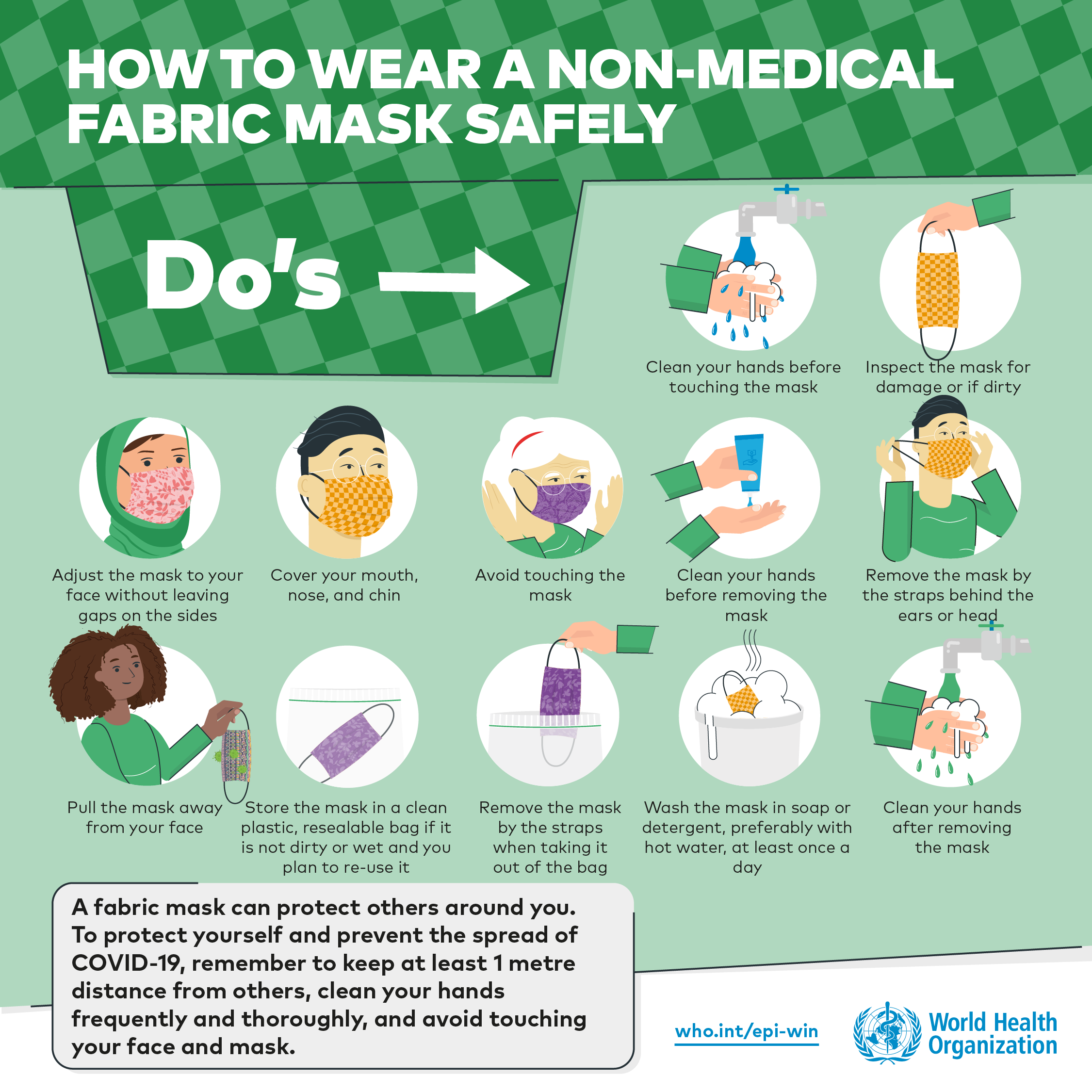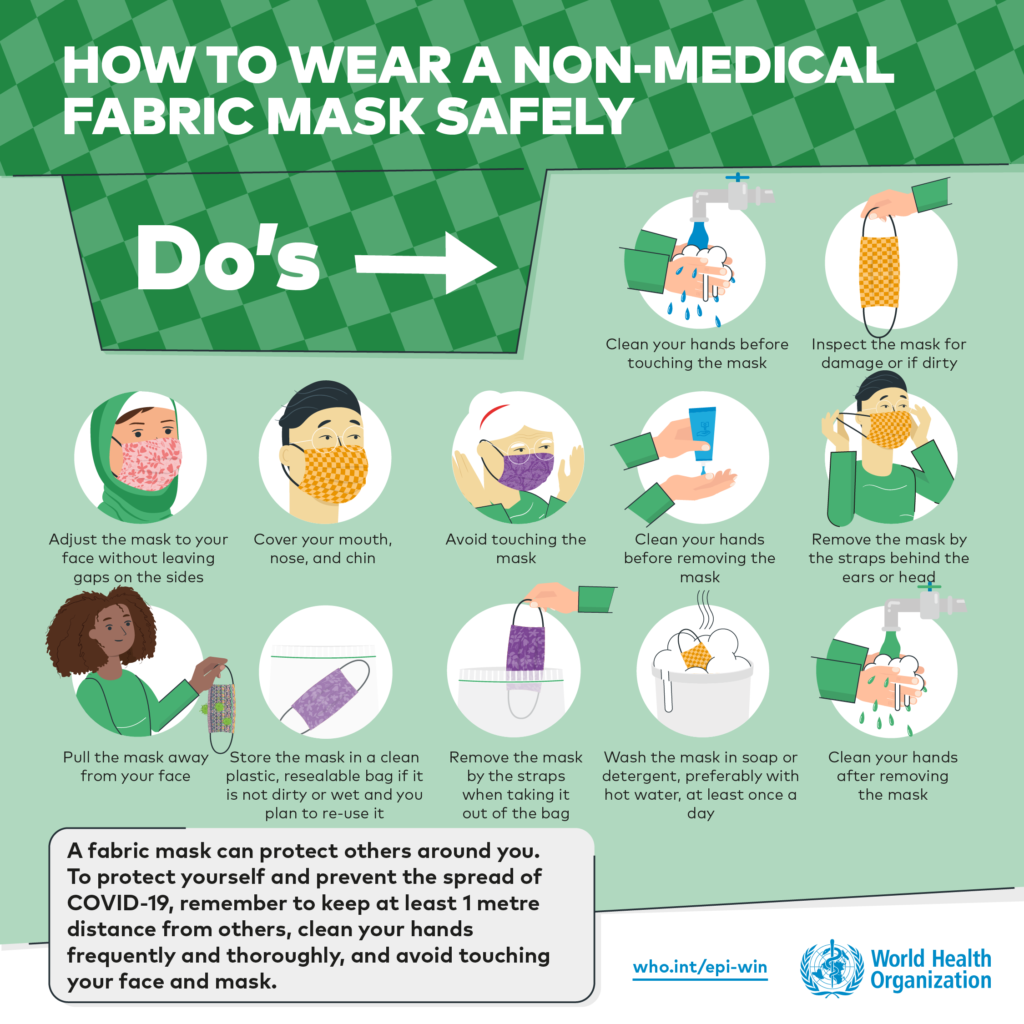Surprising New Guidance from the WHO
The WHO guidance on face masks for COVID-19 has changed to include the recommendation that the general public use fabric masks in public settings where physical distancing can’t be achieved and provides specific guidance on mask layers and materials. According to the World Health Organization (WHO), the ideal fabric mask for use by the general public consists of three layers, where two of the three layers are water-resistant (hydrophobic) materials such as polypropylene, and the third layer in contact with the face is an absorbent (hydrophilic) material such as cotton.
- [Update: December 2020] The WHO updated their guidance to include more details on mask fabrics and testing and requirements. We summarize key points from the updates in a new post on: WHO Fabric Mask Guidance – December Updates
- [Update: August 2020] An overview of the WHO Guidance on Masks for Children has been added (click here for the August 21, 2020 WHO Advice on Masks for Children)
Dr. Maria van Kerkhove, a WHO epidemiologist stated on June 5, 2020 that,
“With those three layers, and in that combination, that fabric can actually provide a mechanistic barrier that if someone were infected with COVID-19, it could prevent those droplets going through and infecting someone else.”
In this post we highlight key points pulled straight from yesterday’s guidance (click here for the full WHO June 5, 2020 guidance) that we wanted to share immediately. Stay tuned! A more in depth review and commentary is underway…
Key points from the new WHO guidance:
Fabric masks are defined as masks made from woven and non-woven fabrics.
“Non-medical (also referred to as “fabric” in this document) masks are made from a variety of woven and non-woven fabrics, such as polypropylene.”
Use of fabric masks is encouraged in public settings where physical distancing cannot be achieved, especially enclosed spaces such as grocery stores, schools, churches, mosques, buses, planes, and trains.
“WHO has updated its guidance to advise that to prevent COVID-19 transmission effectively in areas of community transmission, governments should encourage the general public to wear masks in specific situations and settings as part of a comprehensive approach to suppress SARS-CoV-2 transmission.”
Situations where the general public should be encouraged to use fabric masksfrom: WHO Advice on the use of masks in the context of COVID-19, June 5, 2020 |
|
Situations |
Populations |
| Areas with known or suspected widespread transmission and limited or no capacity to implement other containment measures such as physical distancing, contact tracing, appropriate testing, isolation and care for suspected and confirmed cases. | General population in public settings such as grocery stores, at work, social gatherings, mass gatherings, closed settings, including schools, churches, mosques, etc. |
| Settings with high population density where physical distancing cannot be achieved; surveillance and testing capacity, and isolation and quarantine facilities are limited. | People living in cramped conditions and specific settingssuch as refugee camps, camp-like settings, slums. |
| Settings where a physical distancing cannot be achieved (close contact). | General public on transportation (e.g. on a bus, plane, trains) Specific working conditions which places the employee in close contact or potential close contact with others e.g. social workers, cashiers, servers. |
The ideal combination of materials for fabric masks include 3-layers with a water-resistant (hydrophobic) outermost layer.
“The ideal combination of material for non-medical masks should include three layers as follows:
- an innermost layer of a hydrophilic material (e.g. cotton or cotton blends);
- an outermost layer made of hydrophobic material (e.g., polypropylene, polyester, or their blends) which may limit external contamination from penetration through to the wearer’s nose and mouth;
- a middle hydrophobic layer of synthetic non-woven material such as polypropylene or a cotton layer which may enhance filtration or retain droplets.“
Nonwoven spunbond layers offer adequate filtration and breathability.
“Recent data indicate that two non-woven spunbond layers, the same material used for the external layers of disposable medical masks, offer adequate filtration and breathability. Commercial cotton fabric masks are in general very breathable but offer lower filtration. The filter quality factor known as “Q” is a commonly used filtration quality factor; it is a function of filtration efficiency (filtration) and breathability, with higher values indicating better overall efficiency.”

Masks made with spunbond nonwoven polypropylene and cotton may be boiled or steamed.
“Non-woven polypropylene (PP) spunbond may be washed at high temperatures, up to 125°C. Natural fibres may resist high temperature washes and ironing. Wash the mask delicately (without too much friction, stretching or wringing) if nonwoven materials (e.g. spunbond) are used. The combination of non-woven PP spunbond and cotton can tolerate high temperatures; masks made of these combinations may be steamed or boiled… Where hot water is not available, wash mask with soap/detergent at room temperature water, followed by either
- boiling mask for one minute OR
- soak mask in 0.1% chlorine for one minute then thoroughly rinse mask with room temperature water, to avoid any toxic residual of chlorine.”
Caution: Do not use elastic material for masks.
“It is preferable not to select elastic material for making masks; during wear, the mask material may be stretched over the face, resulting in increased pore size and lower filtration efficiency throughout use. Also, elastic materials may degrade over time and are sensitive to washing at high temperatures.“
Masks should be handled carefully and washed frequently.
“Masks should only be used by one person and should not be shared. All masks should be changed if wet or visibly soiled; a wet mask should not be worn for an extended period of time. Remove the mask without touching the front of the mask, do not touch the eyes or mouth after mask removal. Either discard the mask or place it in a sealable bag where it is kept until it can be washed and cleaned. Perform hand hygiene immediately afterwards. Non-medical masks should be washed frequently and handled carefully, so as not to contaminate other items. If the layers of fabrics look noticeably worn out, discard the mask.“
Guidance and practical considerations for fabric mask production and managementfrom: WHO Advice on the use of masks in the context of COVID-19, June 5, 2020 |
Fabric Selection: |
|
Construction: |
|
Mask management: |
|

WHO Advice on Masks for Children (Update August 2020)
When it comes to important design considerations for masks for children, the WHO advice simply states that,
“The design of face masks for children should take into consideration the overall quality of the fabric, suitable breathability and comfort” and child-friendliness (appropriate size, colours, design, etc.) to help improve their acceptance of and use by children.”
However, the WHO provides more detailed advice about mask use among different age-groups:
Age |
WHO Advice on Masks for Children (August 21, 2020) |
|
| < 5 | Children < 5 should not wear masks for source control | “Based on the expert opinion gathered through online meetings and consultative processes, children aged up to five years should not wear masks for source control. This advice is motivated by a “do no harm” approach… The rationale included consideration of the fact that by the age of five years, children usually achieve significant developmental milestones, including the manual dexterity and fine motor coordination movements needed to appropriately use a mask with minimal assistance.” |
| 6 – 11 | May be Recommended In Some Situations | “For children between six and 11 years of age, a risk-based approach should be applied to the decision to use of a mask. This approach should take into consideration: 1) intensity of transmission in the area where the child is…; 2) social and cultural environment…; 3) the child’s capacity to comply with the appropriate use of masks and availability of appropriate adult supervision; 4) potential impact of mask wearing on learning and psychosocial development; and 5) additional specific considerations and adaptions for specific settings.” |
| > 12 | Follow Mask Advice for Adults | “WHO and UNICEF advise that children aged 12 and over should wear a mask under the same conditions as adults, in particular when they cannot guarantee at least a 1-metre distance from others and there is widespread transmission in the area.” |
It is important to note that this guidance is different than the guidance currently provided by the CDC, which advises the use of masks for children over the age of two when social distancing isn’t possible.
| CDC Advice for Children > 2
(July 21, 2020) |
WHO Advice for Children < 5
(August 21, 2020) |
| “Children 2 years and older should wear a mask over their nose and mouth when in public settings where it’s difficult to practice social distancing. This is an additional public health measure people should take to reduce the spread of COVID-19 in addition to (not instead of) the other everyday preventive actions.” | “Based on the do no harm approach, if the lower age cut-off of two or three years of age is to be used for recommending mask use for children, appropriate and consistent supervision, including direct line of sight supervision by a competent adult… This is both to ensure correct use of the mask and to prevent any potential harm associated with mask wearing to the child.” |
Additional Links/Information
Check appropriate regulatory agencies for local, regional, and national guidance.
- CDC: https://www.cdc.gov/coronavirus/2019-ncov/daily-life-coping/children/protect-children.html
- WHO: https://www.who.int/publications/i/item/WHO-2019-nCoV-IPC_Masks-Children-2020.1
For More Information about Mask Designs Considerations for Children Check Out:




7 thoughts on “WHO Guidance on Face Masks Changes”
Comments are closed.